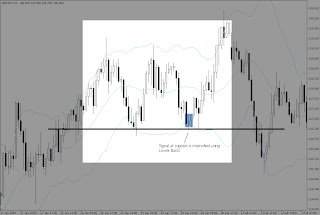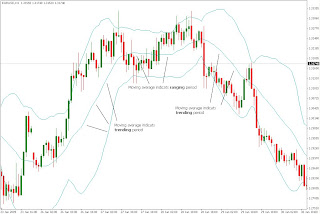Invented in the 1980s by John Bollinger, the Bollinger Bands is one of the mainly used technical indicators in the world of trading. However, its interpretation and power exceeds the standard use in breakout signals. In this article I will show you how you can create profits with simple set-ups and enhance the quality of your trades.
Method no. 1: Support and Resistance
Above all, Bollinger Bands serve as support and resistance.
By defining the lower and upper bounds of price, the bands serve as limits of the price activity - often better than the standard chartists methods. An easy way to incorporate the bands into your trading is to cross-verify trades. For example: Price is touching support and beginning uptrend. A touch at the lower band implies a higher probability of success (Fig. 1). Consequently, if price touched support but it is distant from the bands, most likely it is not a strong support and the trade is likely to fai.
The Bollinger Bands can also be a great place to put stop losses to avoid being cought in stop-hunting events as fakeouts.
Fig. 1: Signal at support is intensified using Lower Band

Method no. 2: Volatility and The 'Squeeze' Trade
Bollinger Bands can also give us a vivid view on the volatility of the market. Bands that are distant indicate a volatile market in which price moves significantly. Bands that are closed together indicate a period of low volatility. A period in which bands are highly closed (Fig. 2) is called a "Squeeze". As we know, market fluctuates from periods of high volatility and movement (trend) to periods of low volatility (range). A breakout of the squeeze usually results in a very strong trend, giving us highly profitable oppertunities.
Fig. 2: The Squeeze and its Result

After a squeeze is identified, one can enter in 2 techniques: Go long\short in the direction of the breakout. This is a simple entry and is profitable. The second technique is for safer and higher-quality trades: Wait for price to touch the Bollinger Moving Average and bounce off to enter. In this way the trades waits for pullback which enhances the trade.
Method no. 3: Identify Ranges and Trends Correctly
Bollinger Bands have one more function, which is very useful and critical to day-traders. The bands can determine whether the prices are in range or in trend. This is done using a simple tool - the Moving Average. The middle band can determine trends and ranges easily - if it is flat, we are at a ranging period. If the middle band is trendy (points to a direction), we are in the middle of trend.
This can enhance your trades in many ways. Examples: Price is near support and you are waiting for signal. If the middle band indicats trending period, it is less likely the price will stop at that level. However, all support\resistance bounces will work better in a ranging period. If middle band is flat, expect price to bounce off support and resistance continously.
Fig. 3: Moving Average defines Trending\Ranging periods

I hope you found this article helpful, Bollinger Bands are a great tool and if used correctly can enhance your trades and increase your profits.
Method no. 1: Support and Resistance
Above all, Bollinger Bands serve as support and resistance.
By defining the lower and upper bounds of price, the bands serve as limits of the price activity - often better than the standard chartists methods. An easy way to incorporate the bands into your trading is to cross-verify trades. For example: Price is touching support and beginning uptrend. A touch at the lower band implies a higher probability of success (Fig. 1). Consequently, if price touched support but it is distant from the bands, most likely it is not a strong support and the trade is likely to fai.
The Bollinger Bands can also be a great place to put stop losses to avoid being cought in stop-hunting events as fakeouts.
Fig. 1: Signal at support is intensified using Lower Band

Method no. 2: Volatility and The 'Squeeze' Trade
Bollinger Bands can also give us a vivid view on the volatility of the market. Bands that are distant indicate a volatile market in which price moves significantly. Bands that are closed together indicate a period of low volatility. A period in which bands are highly closed (Fig. 2) is called a "Squeeze". As we know, market fluctuates from periods of high volatility and movement (trend) to periods of low volatility (range). A breakout of the squeeze usually results in a very strong trend, giving us highly profitable oppertunities.
Fig. 2: The Squeeze and its Result

After a squeeze is identified, one can enter in 2 techniques: Go long\short in the direction of the breakout. This is a simple entry and is profitable. The second technique is for safer and higher-quality trades: Wait for price to touch the Bollinger Moving Average and bounce off to enter. In this way the trades waits for pullback which enhances the trade.
Method no. 3: Identify Ranges and Trends Correctly
Bollinger Bands have one more function, which is very useful and critical to day-traders. The bands can determine whether the prices are in range or in trend. This is done using a simple tool - the Moving Average. The middle band can determine trends and ranges easily - if it is flat, we are at a ranging period. If the middle band is trendy (points to a direction), we are in the middle of trend.
This can enhance your trades in many ways. Examples: Price is near support and you are waiting for signal. If the middle band indicats trending period, it is less likely the price will stop at that level. However, all support\resistance bounces will work better in a ranging period. If middle band is flat, expect price to bounce off support and resistance continously.
Fig. 3: Moving Average defines Trending\Ranging periods

I hope you found this article helpful, Bollinger Bands are a great tool and if used correctly can enhance your trades and increase your profits.
Last edited by a moderator:
